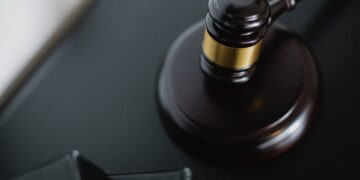D.C. Circuit
Case: United States v. Bikundi, No. 16-3066, 2019 WL 2426147 (D.C. Cir. June 11, 2019)
Type of Case: Criminal
Charges/Counts: Health care fraud; conspiracy to commit health care fraud; money laundering; and conspiracy to commit money laundering
Rule(s) of Evidence Cited
- FRE 901(b)(3)
Holding: The D.C. Circuit held that the jury could identify a particular piece of handwriting as belonging to the defendant by comparing the handwriting to an “authenticated” sample of the defendant’s handwriting.
By way of background, at trial, the government offered two separate documents into evidence, each of which had handwritten notations on it. With respect to the first document, the government called the defendant’s brother, who identified the handwritten notations as the defendant’s handwriting. With respect to the second document, however, the defendant’s brother was unsure about whether the handwritten notations were the defendant’s handwriting. Nevertheless, the district court admitted both pieces of evidence.
On appeal, the defendant challenged the court’s admission of the second document, arguing that the government had failed to sufficiently authenticate it. The D.C. Circuit disagreed, holding that the jury could authenticate the second document using the first document as an “exemplar.” The Court wrote:
“These arguments needlessly make the perfect the enemy of the good — the jury required no definitive identification or expert analysis to apply its own common sense. Cf. 28 U.S.C. § 1731 (‘The admitted or proved handwriting of any person shall be admissible, for purposes of comparison, to determine genuineness of other handwriting attributed to such person.’); Fed. R. Evid. 901(b)(3) (‘A comparison with an authenticated specimen by an expert witness or the trier of fact’ may satisfy ‘the requirement of authenticating or identifying an item of evidence.’ (emphasis added)). Given our standard of review, the key question is what ‘rational juror[s]’ could conclude, not what they had to conclude. United States v. Williams, 836 F.3d 1, 7 (D.C. Cir. 2016). And a reasonable juror — looking at the annotated resume found in [the defendant’s] house and armed with her brother’s testimony — reasonably could find that [the defendant] wrote the website address herself.”
Sixth Circuit
Case: United States v. Potter, No. 18-5830, 2019 WL 2428711, at *1 (6th Cir. June 11, 2019)
Type of Case: Criminal
Charges/Counts: Conspiracy to distribute methamphetamine, in violation of 21 U.S.C. §§ 841(a)(1), 846.
Rule(s) of Evidence Cited
- FRE 401
Holding: The Sixth Circuit held that a district court did not err in admitting, as relevant, the defendant’s statements about prior drug activity.
By way of background, the government offered into evidence the defendant’s statements “that he had bought large amounts of meth in Georgia and resold it in Tennessee.” The defendant argued that these statements were not relevant under Rule 401 because they “discussed different actors (not individuals charged in the indictment) and an earlier time (beginning in August 2014, before the indictment’s January 2015 start date).”
The Sixth Circuit upheld the district court’s admission of the statements. The Court wrote that the statements were unquestionably relevant. And, although the defendant could have raised a 404(b) objection, he failed to do so. The Court wrote:
“[The defendant’s] statements had a ‘tendency to make’ it ‘more … probable’ that he voluntarily joined the indicted conspiracy, which started at roughly the same time and followed roughly the same methods. Fed. R. Evid. 401(a). Indeed, as evidence experts have long recognized, a prior ‘bad act’ satisfies the relevancy test’s low bar even when used to show a person’s propensity to commit the indicted crime. See Old Chief v. United States, 519 U.S. 172, 180–82, 117 S.Ct. 644, 136 L.Ed.2d 574 (1997); 1 John H. Wigmore, Evidence in Trials at Common Law § 55, at 122–23 (1st ed. 1904). That is why a separate rule—Rule 404(b)—prohibits that use of ‘bad acts’ evidence and why most objections to this type of evidence invoke that rule. E.g., United States v. Hardy, 643 F.3d 143, 151–52 (6th Cir. 2011). But [the defendant] opted not to make a Rule 404(b) objection for strategic reasons. Besides, the United States used [the defendant’s] statements for reasons allowed by Rule 404(b)(2), such as to prove his intent. See United States v. Alkufi, 636 F. App’x 323, 332 (6th Cir. 2016).”
Seventh Circuit
Case: Uncommon, LLC v. Spigen, Inc., No. 18-1917, 2019 WL 2426298, at *1 (7th Cir. June 11, 2019)
Type of Case: Civil
Charges/Counts: Trademark infringement and unfair competition
Rule(s) of Evidence Cited
- FRE 702
Holding: The Seventh Circuit noted that a consumer survey almost always requires expert testimony.
The defendant failed to timely identify a witness who performed a consumer survey as an expert witness pursuant to Federal Rule of Civil Procedure of 26(a). Nevertheless, under Rule 37(c)(1), the district court excused the defendant’s failure and ultimately entered summary judgment for the defendant. The plaintiff appealed the district court’s ruling.
On appeal, the Seventh Circuit affirmed. In so doing, the Court noted that, to offer a consumer survey, a party will usually need to have an expert testify. The Court wrote:
“To be admissible, a consumer survey almost always requires expert testimony. This is because conducting a survey entails expertise and the exercise of professional judgment. See Muha v. Encore Receivable Mgmt., Inc., 558 F.3d 623, 625–26 (7th Cir. 2009); Spraying Sys. Co. v. Delavan, Inc., 975 F.2d 387, 394 (7th Cir. 1992). No survey is ‘foolproof,’ and examiners make a range of decisions about sample size, question design, survey format, and statistical analysis—all of which can impact reliability. See Kraft Foods Grp. Brands LLC v. Cracker Barrel Old Country Store, Inc., 735 F.3d 735, 741–42 (7th Cir. 2013); see also 6 McCarthy on Trademarks and Unfair Competition § 32:158 (5th ed. 2019) (“McCarthy on Trademarks”). Expert testimony is therefore necessary to explain the survey’s methodology and to attest to its compliance with principles of the profession. See Fed. R. Evid. 702; Evory v. RJM Acquisitions Funding L.L.C., 505 F.3d 769, 776 (7th Cir. 2007).”
Eighth Circuit
Case: United States v. Medrano, No. 18-1070, 2019 WL 2375235, at *2 (8th Cir. June 6, 2019)
Type of Case: Criminal
Charges/Counts: Conspiracy to distribute and possess with intent to distribute a controlled substance; possession of a firearm in furtherance of a drug trafficking crime
Rule(s) of Evidence Cited
- FRE 401
Holding: In a case where the government charged the defendant with selling drugs in North Dakota, the Eighth Circuit upheld the district court’s admission of evidence of firearms seized from the defendant’s California residence.
By way of background, a witness at trial testified that she had bought methamphetamine from a man named Daniel Ordorica who lived at the defendant’s residence in California. She testified that she, Ordorica, and the defendant then drove a car to North Dakota with the plan to sell drugs there. In North Dakota, the trio sold drugs for several days. The witness also, at Ordorica’s request, bought a Sig Sauer handgun, Although the three planned to return to California, the defendant ultimately decided to stay in North Dakota because his “house got raided down there.” The defendant then told the witness that he needed to keep the Sig Sauer handgun for protection. As it turned out, while the defendant was in North Dakota, police in California had executed a search warrant in the defendant’s home, finding two firearms.
At trial, the government sought to offer evidence of the firearms found in the defendant’s California home. The defendant objected, arguing that those guns were relevant to the drug dealing charges, which focused on the defendant’s alleged dealing in North Dakota. The trial court disagreed. The Eighth Circuit affirmed. The Court wrote:
“[The witness’s] testimony directly linked [the defendant’s] home in California to the charges that he conspired to distribute and possessed with intent to distribute methamphetamine. Thus, it was well within the district court’s discretion to find that evidence of drug trafficking seized in the warrant search of [the defendant’s] California property, including two firearms, was relevant to the drug charges being tried in North Dakota. ‘[W]hen evidence of other crimes is so blended or connected, with the one on trial as that proof of one incidentally involves the other; or explains the circumstances thereof; or tends logically to prove any element of the crime charged, it is admissible as an integral part of the immediate context of the crime charged.’ United States v. Fleck, 413 F.3d 883, 890 (8th Cir. 2005), quoting United States v. Forcelle, 86 F.3d 838, 841 (8th Cir. 1996).”
Tenth Circuit
Case: United States v. Bishop, No. 18-4088, 2019 WL 2414996, at *1 (10th Cir. June 10, 2019)
Type of Case: Criminal
Charges/Counts: Unlawfully manufacturing machineguns, in violation of 26 U.S.C. § 5861(a), and one count of unlawfully possessing or transferring machineguns, in violation of 18 U.S.C. § 922(o).
Rule(s) of Evidence Cited
- FRE 702
Holding: The Tenth Circuit held that the district court did not err in refusing to allow a defendant to testify about his design for a device known as a TCGTR, which is installed in AR-15 semiautomatic rifles to increase the speed at which the guns fire.
By way of background, at trial, an ATF special agent testified about why the TCGTR qualified as a machine gun. When it was the defendant’s turn to present his case, he testified about his design for the TCGTR. He acknowledged that he designed the TCGTR “for an increased rate of fire,” but maintained that he “wanted to do it legally.” The defendant then testified that he designed the TCGTR “to contact the trigger group assembly,” though ostensibly without disabling the disconnector. When the defendant began to testify about what part of the “trigger group assembly” the TCGTR was designed to contact, he asked the court whether he could “show the jury an animation that is on YouTube showing how that trigger group works.” The defendant also offered to draw a diagram of the trigger group on a whiteboard.
The government objected, arguing that the testimony “presents both technical and specialized knowledge and under Rule 702 it would be required to come in through a qualified expert witness.” The district court sustained the government’s objection because it found that the defendant’s testimony concerned “technical and specialized knowledge,” but had not been disclosed as required by Federal Rule of Criminal Procedure 16.
On appeal, the defendant argued that his testimony qualified as lay opinion testimony under Rule 701. The Tenth Circuit disagreed and affirmed the district court’s ruling. The Court wrote:
“‘[T]he distinction between lay and expert witness testimony is that lay testimony results from a process of reasoning familiar in everyday life, while expert testimony results from a process of reasoning which can be mastered only by specialists in the field.’ Fed. R. Evid. 701 advisory committee’s note to 2000 amendment (quotation marks omitted). ‘[P]rototypical examples of [lay testimony include] … the appearance of persons or things, identity, the manner of conduct, competency of a person, degrees of light or darkness, sound, size, weight, [and] distance ….’ Id. (quotation marks and brackets omitted).
Understanding Defendant’s testimony ‘require[d] … specialized knowledge’ about how an AR-15 works and how its component parts can be manipulated to increase the gun’s rate of fire. Yeley-Davis, 632 F.3d at 684 (quoting LifeWise Master Funding, 374 F.3d at 929). Moreover, the jury would have needed to understand the significance of Defendant’s reference to a ‘forced reset trigger system’ and a ‘positive reset trigger system,’ as well as how such systems differ from the analogous system in a machinegun. App. Vol. III at 570. This is not knowledge ‘readily accessible to any ordinary person.’ Yeley-Davis, 632 F.3d at 684. Therefore, the district court did not abuse its discretion when finding that this portion of Defendant’s testimony was expert testimony subject to Rule 702.”
- FRE 704(a)
Holding: The Tenth Circuit held that the ATF agent’s testimony that the “TCGTR ‘meets the statutory definition of a machinegun that is found in 26 United States Code Section 5845(b)’” did not violate Rule 704(a).
By way of background, the defendant had argued that the agent’s testimony was improper because experts may not opine on ultimate issues of fact. The Tenth Circuit rejected the argument. The Court wrote:
“‘An opinion is not objectionable just because it embraces an ultimate issue.’ Fed. R. Evid. 704(a). Moreover, ‘[w]itnesses are permitted to testify about how the law applies to a certain set of facts, so long as they provide adequate explanations for their conclusions.’ United States v. Richter, 796 F.3d 1173, 1196 (10th Cir. 2015). Therefore, as long as Agent Powell explained the basis for his opinion, it was not improper for him to testify that the TCGTR was a machinegun. United States v. Buchanan, 787 F.2d 477, 483–84 (10th Cir. 1986) (holding that an expert witness may testify that “a particular device … must be registered” as a firearm with ATF).”
Eleventh Circuit
Case: United States v. Cooper, No. 17-11548, 2019 WL 2414405, at *1 (11th Cir. June 10, 2019)
Type of Case: Criminal
Charges/Counts: Wire fraud, in violation of 18 U.S.C. § 1343; using a facility in interstate and foreign commerce to promote an unlawful activity, in violation of 18 U.S.C. § 1952(a)(3)(A); attempting to import and importing an alien for an immoral purpose, in violation of 8 U.S.C. § 1328; and attempted sex trafficking and sex trafficking, in violation of 18 U.S.C. §§ 1591(a)(1), 1594(a).
Rule(s) of Evidence Cited
- FRE 901(b)(6); 801(d)(2)(A); The Confrontation Clause
Holding: The Eleventh Circuit held that the district court did not abuse its discretion in admitting a recorded phone call between the defendant and his alleged victim.
By way of brief background, a victim placed a monitored and recorded phone call to a phone number belonging to the defendant. After a brief conversation took place, the victim told a government agent that the person she had spoken with was the defendant. At trial, the government agent testified that the victim, who did not testify, had identified the voice on the recorded call as belonging to the defendant. The defendant argued that such testimony was inadmissible hearsay and violated the Confrontation Clause.
With respect to the authentication issue, the Eleventh Circuit held that the government did not need the victim’s out-of-court identification to authenticate the voice on the call as belonging to the defendant. The Court wrote:
“The trial court had ample basis besides [the victim’s] statement to [the government agent] to find that the voice on the recorded call was [the defendant’s]. The male voice on the phone call discussed the ‘yoga studio,’ responded to the name ‘Jeff,’ talked about his interactions with CCI, and mentioned a note to him identifying him as ‘J.’ These recorded statements, coupled with the government’s evidence tying the 6115 number [the victim] used to place the monitored call to [the defendant], showed that [the defendant] was the speaker.”
With respect to the hearsay issue, the Eleventh Circuit held (1) that the defendant’s statements qualified within the hearsay exclusion for statements of an opposing party and (2) that the victim’s statements were not offered for their truth, but merely to provide context for the defendant’s statements. The Court wrote:
“[The defendant’s] statements on the phone call were admissible as those of a party-opponent. United States v. Munoz, 16 F.3d 1116, 1120 (11th Cir. 1994); see FED. R. EVID. 801(d)(2)(A). And [the victim’s] statements on the recording were not hearsay because they were not admitted to prove the truth of the matters asserted, but to give context to the admissible statements. See United States v. Price, 792 F.2d 994, 996 (11th Cir. 1986).”
With respect to the Confrontation Clause issue, the Eleventh Circuit held that it was not implicated because the statements of the victim were not offered for their truth. The Court wrote:
“Because the Confrontation Clause ‘does not bar the use of testimonial statements for purposes other than establishing the truth of the matter asserted,’ and because these statements were not hearsay, the district court did not err or violate [the defendant’s] Confrontation Clause rights in admitting them. Crawford, 541 U.S. at 59 n.9, 124 S.Ct. 1354.”
- FRE 404(b)
Holding: The Eleventh Circuit upheld the district court’s admission of a book and transcripts of other calls relating to other, uncharged prostitution activities.
The defendant argued “that the conversations and the book were admitted ‘for the improper purpose to show [the defendant] had the propensity to engage in prostitution.’” The Eleventh Circuit rejected the argument. The Court wrote:
“The district court did not abuse its discretion in admitting these exhibits. They were relevant to issues other than [the defendant’s] character, including his intent to continue to operate his sex business, knowing the type of business it was. The government had to prove that [the defendant’s] actions were part of ‘a continuous course of conduct.’ See United States v. Lignarolo, 770 F.2d 971, 979 (11th Cir. 1985). Evidence of later instances when [the defendant] arranged to sell sexual services for money was relevant to show that [the defendant] continuously engaged in his business of selling sexual services to paying clients, knowing the type of acts involved. See United States v. Edouard, 485 F.3d 1324, 1345 (11th Cir. 2007). Because the exhibits were probative of the continuing nature of [the defendant’s] business, and because the probative value substantially outweighed the risk of unfair prejudice, the district court did not err in admitting the exhibits.”











